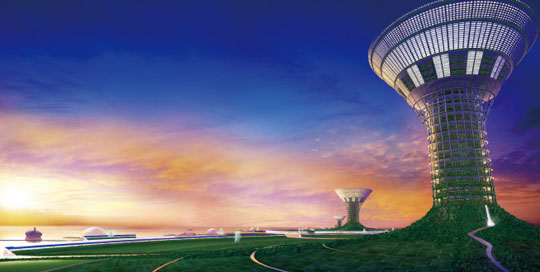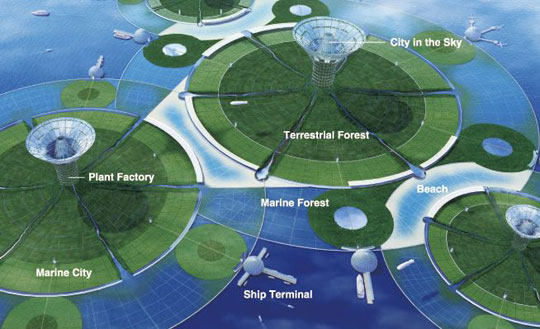In 2025, people in the future can live in lilies shaped towers built on floating cities on the Pacific Ocean.

Each floating island has a central tower with a capacity of 10,000 - 50,000 people. (Photo: Internet).
According to the Daily Mail , construction technology company Shimizu has introduced a model of a floating city on the Green Float. These green cities will help reduce the load on cities on the mainland that are becoming increasingly crowded and polluted.
A Green Float city will consist of many floating " islands ". Each island will have a central tower with a diameter of 1 km. These islands will float freely on the waters near the equator in the Pacific or can be joined together to form a big city or a sea state.
The central tower of each island is capable of accommodating 10,000 to 50,000 people. They will be surrounded by forests, grasslands and food-producing farm areas serving the island. In addition, each island has a seaport, airport and private beach.
The material used to build the towers is super light alloy. Meanwhile, the underwater part of the island will be constructed of magnesium-plated metal to counteract corrosion of seawater.

Artificial islands are connected to a mass to create a floating city on the Green Float. (Photo: Internet).
Shimizu also came up with the idea of creating a floating city that could cut carbon emissions by 40%. To achieve this goal, waste on each island will be collected and recycled with the latest green technologies. In addition, the consciousness of the people on the islands also plays an important role.
Special technologies will also be applied to protect floating cities from tidal waves and inclement weather. To counteract the big waves, a layer of material with good resilience and strength will be attached to the outer ring of the islands.
In addition, Shimizu engineers also consider the possibility of building sea walls to protect the islands from the tsunami threat. However, the devastating power of tsunamis in offshore areas is less than in coastal areas.
Shimizu hopes to build the first floating islands under this model in 2025. Currently, the research team is still focusing on developing new technologies for the construction of this future work.
 Norway built the world's tallest wooden tower
Norway built the world's tallest wooden tower Kremlin
Kremlin Ashurbanipal: The oldest royal library in the world
Ashurbanipal: The oldest royal library in the world Decoding the thousand-year construction of Qin Shihuang shocked the world
Decoding the thousand-year construction of Qin Shihuang shocked the world Unique delicious rice variety in flood season, the more flooded the higher the yield in An Giang
Unique delicious rice variety in flood season, the more flooded the higher the yield in An Giang  Project to build a floating city with a capacity of 20,000 people
Project to build a floating city with a capacity of 20,000 people  If Earth is destroyed, will we be able to migrate to another planet?
If Earth is destroyed, will we be able to migrate to another planet?  Why is there a phenomenon of ships floating on the sea?
Why is there a phenomenon of ships floating on the sea?  Floating farm - The future of the Dutch livestock industry
Floating farm - The future of the Dutch livestock industry  Marine Environmental Restoration: Female Scientist Wins Excellence Award
Marine Environmental Restoration: Female Scientist Wins Excellence Award 